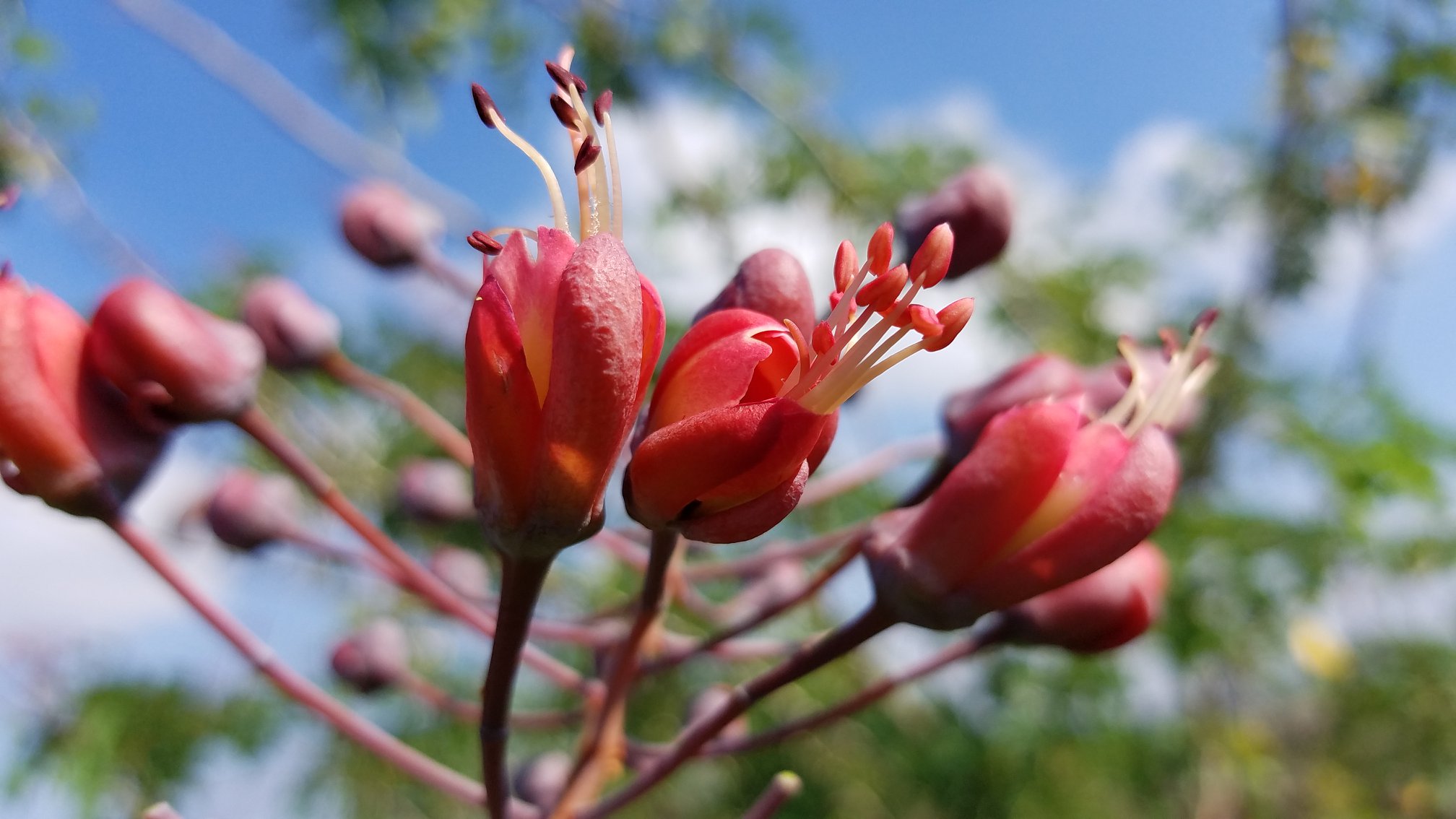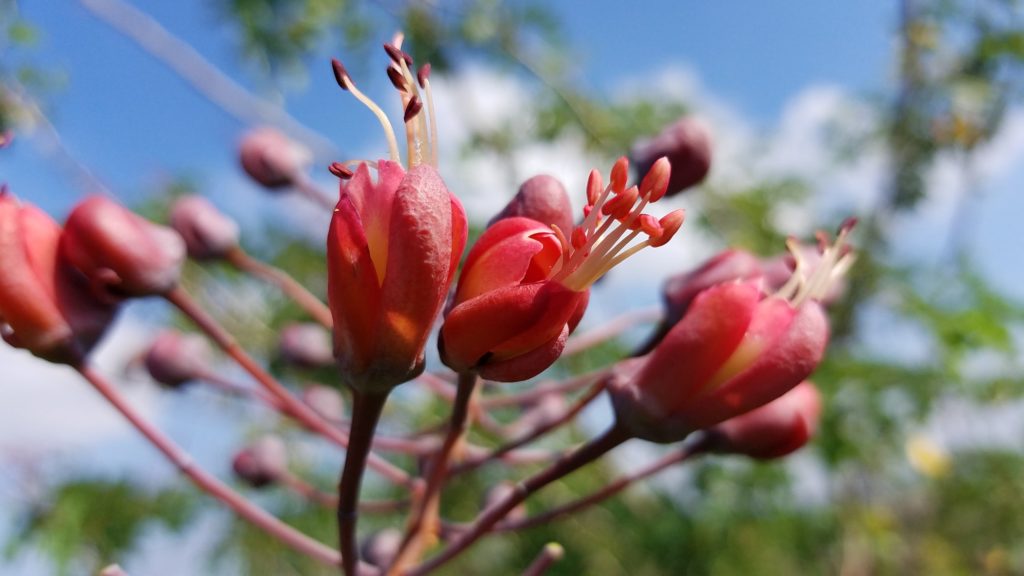PART II: Talk Story With Big Island Conservationist Kassie Conner


Here we get to know some of Kassie’s most memorable experiences working in conservation, information on invasive plants and one of her favorite plants here on Big Island.
For Kassie’s background and work with Hawai’i’s ‘Ōhi‘a Lehua check out PART I of the Talk Story with Kassie Connor in our previous blog!
You’ve been to the most remote corners of Big Island, some places that most people will never see. What do you think is the most awe struck moment you’ve had in your work so far?
Kassie: I have found myself awe struck quite a few times working in this field but I would have to say one of my favorite experiences was collecting point data for uhiuhi (Mezoneuron kavaiense). Uhiuhi is a critically endangered species of dry forest tree with less than a dozen wild plants left in existence and the day I saw one of these giant, ancient trees I remember feeling cold even though I had just hiked two and a half hours in the Kona sun. It was an incredible feeling knowing that you are looking at a species that used to be prolific across the landscape and realizing you are witnessing the fragility and harshness of life on this planet. There have been more moments working with critically endangered species where I have felt this same wave of ice come across me and a sense of unworthiness and honor to be a part of a moment in time where some of these species will inevitably blink out of existence. Working in conservation is wildly exciting and rewarding but the sense of humility and connection to a wider understanding of what this world has created and still holds is honestly the most awe inspiring piece of it all for me.
What is something you wish more people knew about helping with invasive plants?
Kassie: Something that I learned about invasive species that I was thoroughly taken aback by is that THEY SELL KNOWN INVASIVE SPECIES IN OUR STORES! I think it is naturally thought that invasive species are here because they were accidentally brought over without realizing the consequences they would have on the environment or that invasive species are evil stow-aways that hide themselves in our shipping containers until they reach the shore and then make a break for it but we actually actively sell species that are damaging our ecosystems on the nursery racks as landscape flora. This isn’t because there are people that don’t care about the environment but more so that people see a plant they are really drawn to without realizing it is invasive in Hawai’i and inadvertently support invasive species by purchasing that plant for their homes. One of my absolute favorite resources for people when they ask what kind of plants they can put in their landscape, both native and non-native, is Plant Pono. They have information on what plants are at a ‘high-risk’ of becoming or are known to be invasive as well as list ‘low-risk’ landscape plants that are comparable to those that have damaging effects.
What’s something you think people should keep in mind while foraging for flowers or plants to preserve?
Kassie: I think the most important aspect to remember is that many native Hawaiian plants hold an abundance of cultural significance and some of these plants may not be appropriate for everyone to gather if they have not sought out the knowledge on how to respectfully gather and use these resources. Speaking to a local cultural practitioner if you are unsure of certain native plant gathering practices will always be extremely insightful and helpful in your endeavors. If you are wanting to gather from state forests and land there is a permit you can request from DLNR that has tips to prevent the overharvesting of a plant and shows areas where gathering is and is not allowed. It is of course important to be conscious of your surroundings so you do not damage the plants you intend to harvest from as well as others in the ecosystem so you can preserve these resources for future generations to enjoy as well.
From your experience, what is a plant on the Big Island that seems underrated but to you is actually complex and beautiful?
Kassie: I think Hō‘awa (Pittosporum sp.) is very underrated and not as widely known as it should be. There are many varieties that can be found across the Hawaiian islands and are found in multiple ecosystems, from dry forest to high wetlands. It has these small stunning cream colored flowers that form tons of large, sweet-smelling bunches along their branches. The flowers then turn into hard fruit pods that burst open to reveal the black sticky seeds. Some of the varieties have a rust colored pubescence on the leaves giving them an orange shimmery color in the sun and there are so many different sizes that I honestly get very giddy every time I see a new species.
Does it hold cultural significance to Hawai’i/ legend?
Kassie: With how striking these plants are I am sure there are stories and significance of this plant that I have yet to learn of, but one of the most interesting things I have learned about hō‘awa is that it is thought that the ʻAlalā, also known as the Hawaiian crow, is thought to be the last living native distributor of ho’awa seeds across the landscape. If you are not familiar with the ʻAlalā, it is a corvid species that is extinct in the wild and can only now be found in captivity in breeding programs with the hopes of one day being released back into the wild. Because the Hō‘awa pods are so hard and many of our existing native birds are so small, there are no species distributing the seeds. Hō‘awa is still common in our forests but it will be interesting to see how losing ʻAlalā in the landscape for an extended period of time will affect future populations.




Leave a Reply Cancel reply
Subscribe to the Newsletter
Sign up to see what's IN BLOOM with updates and special offers!
Thank you!
You have successfully joined my newsletter :)
let's stay connected!
based in
San diego, CA
bettymoonstudios@gmail.com